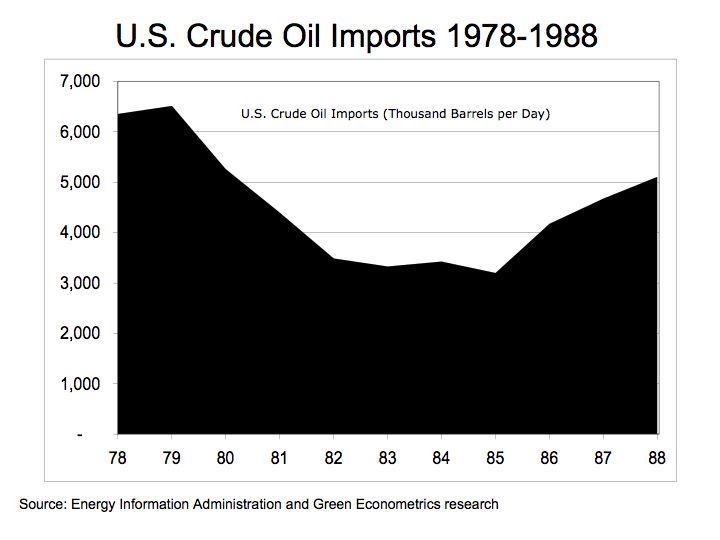Don’t let the fall in Oil Prices Lead to Energy Complacency
The precipitous drop in oil prices may not hold for long. Speculators and fears of oil flow disruptions drove oil prices to an all time high of $145.16 on July 14, 2008 and is now down to $49.50 in November 20, 2008. Now the fear has shifted to the economy where deteriorating fundamentals suggest demand for oil will abate, at least in the near term. However, if history is any guide, demand for oil should be influenced by both structural changes such as consumers driving more fuel-efficient motor vehicles and cyclical factors such as the state of the economy.
Figure 1 US Historic Oil Imports 
To get an understanding of the impact that both structural and economic factors had in reducing the demand for oil is to look at oil import from 1978 to 1988. Figure 1 illustrates the US demand for oil during the last major economic recession. The Oil Shock of the 1970’s severely impacted the US economy and the term stagflation captured our attention while interest rates reached exorbitant levels. From 1979 to 1982, US oil imports decline by 46% as the oil embargo of 1973 led to structural changes in oil consumption. US oil imports, as measured by the Energy Information Administration in U.S. Crude Oil Field Production (Thousand Barrels per Day) demonstrated a significant decline as a result of changing driving habits as fuel efficient import vehicles encroached on the domestic auto makers. The US consumers opted for foreign vehicles demonstrating higher fuel efficiencies and MPG entered our lexicon. These economic and structural changes dramatically reduced the demand for oil and subsequently, oil prices fell. It was not until 1985 before oil imports began to increase.
What’s missing from this analysis is the fact that during this period the US accounted for 27% of total world oil demand. . According to the Energy Information Administration (EIA), in 1980, China and India accounted for 2.8% and 1.0%, respectively, of the global demand for oil. In 1986, China and India increased their oil demand to account for 3.2% and 1.5% of the world market, respectively, an increase in oil demand of 57% for China and 44% for India.
In 2005, China and India account for 8.0% and 2.9% of global oil demand while US dropped to 24.9% of global oil demand. While even China and India are not immune to the current blissful economic environment, when the global economy does improve, their demand for oil will more than negate any structural changes the US consumers make in their driving habits. The demand for oil should continue to grow as an economic recovery ensues thereby leading to an increase in oil prices.
Figure 2 China and India Oil Consumption 
Figure 2. illustrates the rapid rise in the demand of oil from China and India. From 1980 to 2005, demand for oil increased 280% in China and 125% in India. Despite the improving fuel consumption in the US, the global oil market is more apt to be impacting from the growth in developing countries than conservation in the US.
The bottom line: don’t remain complacent, strive for energy efficiency and invest into alternative energies.
For further reading on oil prices please refer to
oil price analysis .
Related Posts